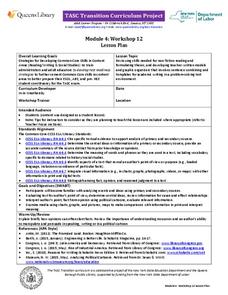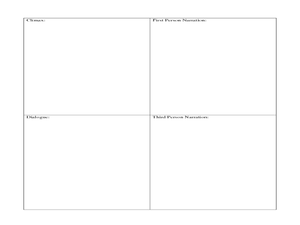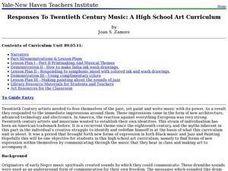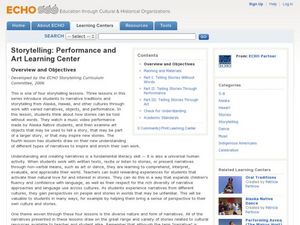EngageNY
TASC Transition Curriculum: Workshop 12
How can opinions slant facts? Workshop participants learn how to examine primary and secondary sources and identify the author's point of view. They also examine how visual art impacts the meaning and rhetoric of sources. Full of...
Curated OER
Illustrating the Elements of a Story
Explore the elements of a story with this two-page graphic organizer. Readers write and draw descriptions of each element, including setting, plot, conflict, rising action, climax, dialogue, and narration.
National Gallery of Canada
Build a Neighbourhood
What's special about your neighborhood? Build one with your class to find out. Individuals create their dream homes that, when completed, will be placed together around a green space in order to create a neighborhood. Learners also...
Curated OER
Techno-shapes
Explore the concept of shapes by using tools in Kid Pix Deluxe 4 computer program. This techno-shapes lesson plan has pupils watching a video about shapes, and using the Kid Deluxe 4 computer program to draw shapes. They get to design...
J. Paul Getty Trust
Expressing Emotions through Art Lesson 2—Everybody Needs Somebody
Young scholars investigate drawings of couples. In this art history lesson plan, students examine the techniques artists use to convey emotions such as caring, love, and togetherness. Young scholars utilize these techniques to create...
Curated OER
Redistricting: Drawing the Lines
Difficult redistricting concepts are covered in a context that will make it understandable to your government scholars. They begin with a KWL on the term redistricting and then watch a video to answer some questions. They analyze...
Curated OER
Responses To Twentieth Century Music: A High School Art Curriculum
Students explore their own responses to sound by hearing the music as a regular part of the class structure. They develop an awareness that certain art evokes certain sounds and moods and develop an intuitive responses to the music.
Curated OER
Use Details from Text to Identify Cause and Effect, Draw Conclusions, Compare and Contrast
Third graders discuss research topics and write a paragraph on one of the provided questions. They focus on including key words from charts that the class has been compiling. They underline supporting details within the text they write....
Curated OER
Storytelling: Performance and Art Learning Center
Tenth graders explore the process of telling stories without words. In this literature lesson, 10th graders watch a music video performance made by Alaska Native students, and then examine art objects that may be used to tell a story,...
KIPP 3D Academy
Epic Poetry Unit
The Odyssey is the core text in this unit study of the hero's journey motif. Along the way, kids research Greek and Roman history, mythology, art, and epic poetry. The 104-page packet is perfect for homeschool or classroom situations and...
Curated OER
Using Fabrics in Your Art Curriculum
Students use a dicut machine to do block printing on fabric. In this fabric lesson plan, students draw, carve, and print onto blocks for this art project.
Curated OER
Racism, Gender, Ethnicity, and Aesthetics in the Art of Graffiti
Students describe how graffiti is a part of everyday culture. They develop basic vocabulary terms for thinking and writing about graffiti and make and justify judgments about aesthetics qualities in graffiti art. They compare and...
Curated OER
Project-Based Learning and the Arts
What's so great about Project-Based learning? Read to learn how projects can help kids apply higher-order thinking skills, conduct thoughtful investigations, and make cross curricular connections. This short article includes five...
Curated OER
Choosing and evaluating a range of subject matter, symbols, and ideas
Art is a great way to convey or express an idea. Learners choose an idiom, draw it, and use transfer paper to create photograms. They discuss how why they chose the phrase they did, and how they expressed that idea through their drawings.
Curated OER
Highlights of Modern American Family Art and Literature
Students develop imagery in literary and art works. They discuss Jacob Lawrence's painting, the "Tombstones, 1942", which conveyed overcrowded tenements and families living in Harlem (New York, New York). They design picture stories...
Curated OER
An Introduction to the Relationship Between Composition and Content in the Visual Arts
Students identify different kinds of narratives used in a number of art works, discuss artist's use of compositional elements to further the story and/or convey a message within a work of art, and explain relationship between composition...
Curated OER
The Art Box
Sixth graders create a 3-D Art Box in this design-oriented art project for the 6th grade. Rubric is included for grading purposes. The elements of design are covered and applied (includes line, form, texture, shape, value, color, and...
Curated OER
The History of Art
Teachers can use these art history lesson plans as a way to get students to look at art in a new light.
Curated OER
Using Details from the Text
Explore non-fiction comprehension strategies with your class. They will visualize daily activities and label a 4 circle Venn diagram with related phrases. They must identify the overlapping sections as "main ideas," then complete a...
Kelly's Kindergarten
June Daily Activities
This is an absolute must-have resource for early elementary teachers! Here you'll find a collection of activities and worksheets for each day of the month of June, with topics ranging from ordering numbers on a calendar or identifying...
University of Minnesota
Beautiful Brain: Step Inside the Brain
Before digital microscopes, scientists hired artists to draw the things visible in the microscope. Through training in neuroscience and art, Cajal revolutionized the way we view the beautiful brain. The third lesson in a series of four...
University of Minnesota
Beautiful Brain: Brain Inspiration
"Neuroscientists consider Cajal as important to their discipline as Einstein is to physics." The first of four lessons has scholars view Santiago Ramon y Cajal's drawings of neurons. They reflect and respond to the art through writing...
National Gallery of Canada
Home Sweet Home
What are your pupils' homes like? Incorporate their homes into a drawing lesson. Using an enlarged photograph, class members draw a grid so they can easily split their drawing in half. The final product should demonstrate cool colors,...
Sargent Art
Protect Our Marine Life
Encourage water conservation and boost art skills with a hands-on activity that challenges young painters to create a scene highlighting marine life. Using oil pastels, scholars draw an underwater scene and write a tip for viewers to...

























